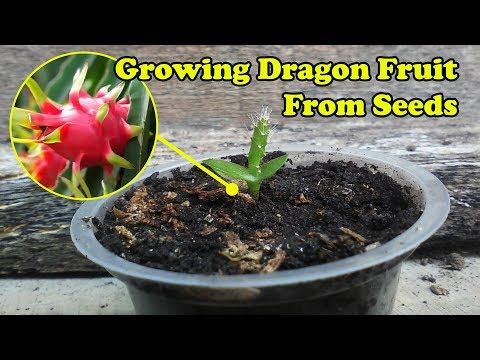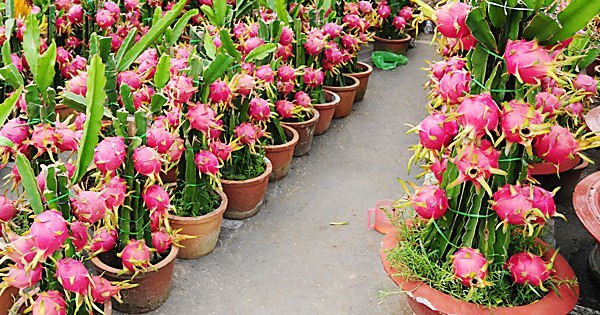Dragon fruit, with its dazzling appearance and succulent taste, has become a sought-after addition to gardens worldwide. grow dragon fruit (exotic fruit) involves a delicate dance of art and science, from germination to fruition. In this guide, we’ll explore the intricacies of growing dragon fruit, delving into specialized techniques and uncommon terminologies to enhance your horticultural repertoire.

Table of Contents
How to Grow Dragon Fruit from Seed
Grow dragon fruit from seed is an interesting experience that calls for dedication, close attention to detail, and a little bit of horticultural skill. To start your journey to grow dragon fruit from seed, adhere to these detailed instructions:

Supplies Required:
Fresh dragon fruit seeds: Grab the seeds from a ripe dragon fruit. Make sure they are viable and fresh.
Soil That Drains Well: You can mix sand, perlite, and peat moss together or choose a cactus or plant compost.
Containers: To avoid waterlogging, use tiny pots or seed trays with drainage holes.
Watering Can or Spray Bottle: Use a spray bottle or watering can to keep the soil consistently moist without going overboard.
Plastic Wrap or Seed Trays with Lids: To facilitate germination, provide a humid environment using plastic wrap or seed trays with lids.
warm location with indirect sunshine; look for a place that is approximately 70°F (21°C) in temperature.
Steps:
- Extracting Seeds: Use a spoon to remove seeds from a ripe dragon fruit. Rinse them well to get rid of pulp.
- Seed Drying: Give the seeds a day or two to air dry. This aids in removing too much moisture.
- Germination Medium: Add well-draining soil to the pots or seed trays, making sure to leave some room at the top.
- Planting: Lay the seeds on the top of the soil and press them down slightly, but do not bury them.
- Seed Covering: Apply a thin layer of soil to the seeds. Mist some water on the surface.
- Humidity Enclosure: To produce a humid atmosphere, cover the pots or trays with plastic wrap or use seed trays with lids.
- Transplanting Seedlings: Move seedlings into bigger pots after they are solid and have a few genuine leaves.
- Sunlight Exposure: Start seedlings off with brief exposures to direct sunlight and gradually increase them.
- Regular Watering: Avoid wet circumstances that might cause root rot by watering when the soil feels dry.
- Support Structures: Because dragon fruit plants are climbers, use trelli or posts. Encourage their ascent.
- Moving Outside: As the weather permits, adapt seedlings to outside conditions gradually.
- Maturity and Fruit Production: Give your dragon fruit plant time to mature; fruit may not appear for a few years.
Although growing dragon fruit from seed requires time and attention, the process is ultimately rewarded when you can harvest your dragon fruit.
How to Grow Dragon Fruit in Pots

Dragon fruit can be grown in pots, which is great for people who live in cities or don’t have a lot of room. Grow dragon fruit in pots is a delicate process that needs to be carefully thought out. Selecting the right container is essential; use pots that have plenty of drainage to avoid waterlogging, which is a common enemy of succulent plants. Sand, perlite, and peat moss are blended to create a symphony of materials in the soil mix, which achieves the precise balance of ventilation and drainage required for dragon fruit production.
The roots’ dance in the small space of a pot produces a special activity. As the dragon fruit plant takes root, the container transforms into a tiny paradise of beautiful plants. Support structures, such as trellises or posts, are not only functional but also aesthetically pleasing additions that give the potted display a vertical dimension.
Dragon Fruit Plant Growth Stages
A dragon fruit plant’s life is like a botanical ballet, with growth phases planned and presented over time. Figuring out the complex dance moves is similar to understanding the stages of growth for dragon fruit plants.

Performance of Germination: The ballet begins with the appearance of a set of delicately leafed seedlings looking for the sunlight’s brilliance.
The vegetative phase is characterized by a ballet de deux between the roots and the shoots. As lush greenery grows, it needs a precise ratio of nutrients, water, and sunlight.
Blossom Ballet: The final blossom waltz is a display of the artistic ability of nature. Bright flowers bloom on the sphere, anticipating the advent of the much-desired dragon fruit.
It takes more than simply horticulture knowledge to comprehend and enjoy these growth stages; rather, it requires an absorption into the artistic ballet of nature.
How to Grow Dragon Fruit at Home
Knowing the specifics of grow dragon fruit at home is essential to converting your living area into a dragon fruit heaven. Growing dragon fruit at home is a comprehensive project that involves more than just gardening; it involves establishing a setting that closely resembles the natural environments in which dragon fruit is found.
- Sanctuaries with sunlight: Find places in your house that receive plenty of sunlight so that the dragon fruit can thrive there. A sunny windowsill or a well-lit balcony might serve as the venue for this botanical show.
- Symphony of Temperature: To make sure the dragon fruit feels comfortable, keep the temperature between 65°F and 75°F (18°C and 24°C) at its ideal range. Protect it against cold so that the plant can grow in an environment that is similar to its tropical birthplace.
- Structural Support: Provide a strong framework for the dragon fruit’s upward journey, understanding that it is a climbing plant that benefits from a framework.
Creating a conducive environment at home involves a mindful blend of aesthetics and functionality, where the dragon fruit becomes a living art piece within your abode.
How Long Does Dragon Fruit Take to Grow from Seed
When exploring the temporal aspect of dragon fruit farming, patience turns into an ally as well as a virtue. The question of how long it takes dragon fruit to germinate, grow vegetatively, and eventually bear fruit occurs frequently.
The time it takes for a seed to develop into a fully developed, fruit-bearing plant is evidence of the cultivator’s dedication. The botanical story is expanded upon every day, spanning from months to years. The dragon fruit teaches its bearer the virtue of maintaining a living thing through its whole lifetime and the art of patience with its slow and methodical growth.
How to Grow Dragon Fruit from Cutting
Quickening the story of botany requires utilizing the lyrical power of cutting propagation. A new chapter in horticultural poetry is opened by learning grow dragon fruit from cuttings, a technique that expands the genetic legacy of the plant.

Picking Out the Muse: Select a robust section to serve as your motivation for this inactive project. Let it develop callosity, a defense mechanism that increases its toughness.
Nesting in the Medium: Carefully nestle the cutting into a soil that drains properly, therefore arranging the beginning of a new botanical stanza. A genetic clone, this cutting sets out on a roots-spreading trip.
The propagation arts is more than just a method; it’s a poetic representation of the continuity of nature, with each cutting serving as a stanza in the continuous poem of horticultural existence.
Conditions to Grow Dragon Fruit
Deciphering the elemental preferences that control dragon fruit development is the first step toward cracking the code of prosperity. The guidelines for raising this unique marvel are based on a complex set of factors known as dragon fruit growing conditions.
Solar Symbiosis: grow dragon fruit has a symbiotic relationship with the sun’s energy, allowing it to flourish in sunlight. Enough direct sunshine is needed each day to guarantee maximum photosynthesis and energy generation.
Harmony of Heat: In a range of 65°F to 75°F (18°C to 24°C), the dragon fruit thrives, and temperature becomes a dance of harmony. Protecting it from frost helps it retain the delicate balance needed for long-term growth.
Soil Alchemy: The soil requires alchemical care since it serves as a canvas for the growth of plants. A pH that is slightly acidic and well-aerated establishes the conditions for healthy roots and optimal nutrition uptake. This alchemical soil becomes the basis for the complex growth of the dragon fruit.
Hydration Ballet: Watering is a ballet of hydration; it’s more than just a routine. By letting the soil dry out in between waterings, you may avoid the threat of root rot and guarantee a beautiful dance with water.
Comprehending and coordinating these circumstances transforms the production of grow dragon fruit from a simple horticultural endeavor to a sophisticated orchestra of ecological awareness.
Conclusion
Every phase of the grow dragon fruit process, from seed germination to mature plants delivering mouthwatering fruits, creates a unique botanical tapestry. The voyage involves a patient wait for results, a dance with the sun, and a beautiful rhythm with the elements. Grown from seeds or cuttings, in pots, or on the open ground, the technique of cultivating dragon fruit is a horticultural marvel that reflects the complex beauty of the plant itself.
To learn more about dragon fruit specialties, click here.
